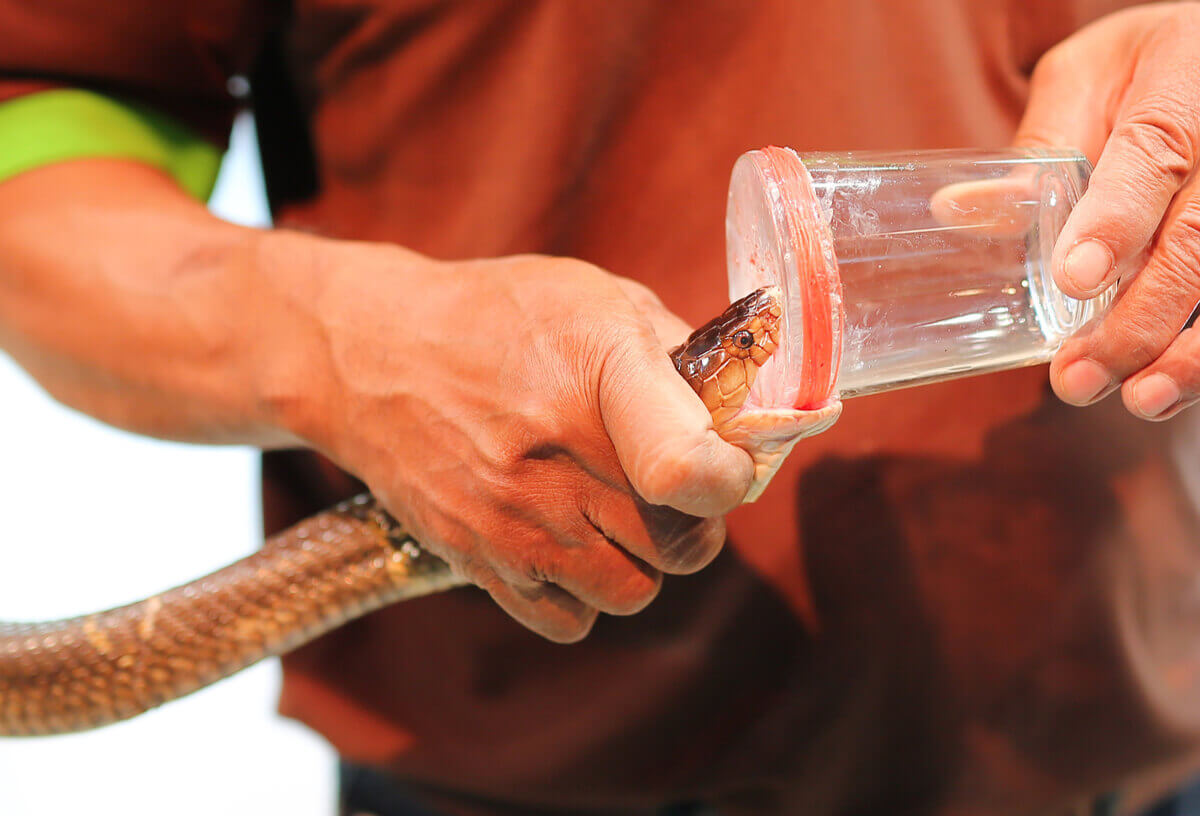Is Snake Venom An Unexpected Cure?


Written and verified by biochemistry Luz Eduviges Thomas-Romero
Are you afraid of snakes? Currently, there are approximately 3,000 known species in existence. However, only the snake venom of 450 of those species is potentially dangerous to human beings.
Just the same, their poison kills approximately 100,000 people each year, mainly in Asia, Africa, and Latin America. Despite this unfortunate statistic, medical discoveries utilizing snake venom are saving human lives.
It’s worth mentioning that each snake species has developed its venom in order to achieve an exquisite specificity regarding weak points in their prey and predators. So, skilled scientists are attempting to unravel the formulas that nature has perfected for medicinal purposes.
Defense and predation
It’s important to point out that venom can contain hundreds of different components. Therefore, this compound is a complex mixture of pharmacologically active components.
The nature of venom varies according to each species. What’s more, even within the same species, the composition changes sightly according to geographic distribution, age, sex, and diet. As for the components of venom, they possess different functions:
- For example, some toxins, known as neurotoxins, affect the nervous system. It’s common for neurotoxins to impede the transmission of signals to the brain, causing paralysis.
- Others, known as hemotoxins, affect the circulatory system. In this case, they can cause red blood cells to burst or the blood to clot. Also, they can lead to dangerously low blood pressure.
- At the same time, there are also mycotoxins, which damage the muscular system. These toxins cause the death of muscle tissues and prevent muscle contraction, causing necrosis.

Snake venom as medicine
According to several studies, the toxins in snake venom evolved for millions of years to fulfill a specific function. With this in mind, scientists aim to isolate these toxins. And they hope to slightly adjust them and use them as the basis of new effective medications.
Exquisite selectivity is an advantage that these toxins have in order to use them as possible therapies. That’s because they minimize the possibility of undesired side effects. What’s more, given their potential, even small amounts can have significant effects.
Currently, there are innumerable possibilities when it comes to developing new medications. For example, pain killers, diabetes medications, and even for cancer treatments. In fact, right now there are medications on the market that were derived from modified toxins.
According to experts, an estimated 20 million toxins remain unexplored in nature.
Ancient knowledge and the use of snake venom
What’s more, in the world of ancient Greece, people considered snakes to be the gods of medicine. In fact, the symbol of the snake continues to be be used for medicine and pharmacy.
Ayurvedic medicine used snake venom to treat pain, inflammation, and arthritis. What’s more, the Chinese have used snake venom for centuries in order to treat opiate addiction. At the same time, Indians combined it with opium in order to treat pain.
Various medications based on snake venom are already on the market
Currently, there’s a massive focus worldwide on the use of toxins in the development of new medications. Just the same, there are only a few of these medications already on the market. Many of these compounds inhibit blood clots in different ways and serve as a treatment against heart attacks. For example:
- Captopril, exenatide, liraglutide, and eptifibatide all come from the venom of the Brazilian snake Bothrops jararaca. These medications help treat hypertension and congestive heart failure. Captopril was the first medication that scientists developed from snake venom in the 1970s.
- A derivative of the venom from the pygmy rattlesnake miliarius barbouri helps prevent acute cardiac ischemia.
- Venom from the Echis carinatus snake is used to produce the medication tirofiban, which inhibits platelet aggregation.
- Purified venom from the species Bothrops moojeni has led to medication for acute heart attacks, chest angina, and sudden deafness.
- A purified blood clotting factor from the species Bothrops atrox is used to treat hemorrhages of a variety of origins.
A source of new painkillers?
The toxins in snake venom also have the potential to become new painkillers. For example, the toxin crotalfina, from the venom of the Crotalus durissus is capable of inducing pain relief through modulation of opioid receptors.
In 2012, a group of researchers found peptides with analgesic effects in the venom of the black mamba, Dendroaspis polylepsis. These toxins, known as mambalgins, function by blocking ion channels in the neurons that transmit pain.
This study led to a renewed interest in ion channels as a therapeutic target. Unlike drugs like morphine, the advantage of mambalgins is that they maintain their effectiveness despite continuous use. Scientists hope that these toxins will lead to the development of a non-addictive alternative to morphine.
New findings regarding three-finger toxins
It’s very interesting to know that certain proteic toxins in many snake venoms possess a particular molecular structure. We know them as three-finger toxins (TFT), which usually correspond with the most active components of each venom.
This group of toxins is already in use thanks to the action it produces on blood vessels. For example, the Muscarinic acetylcholine(MTα) offers treatment for blood pressure disorders. Other toxins–like KT-6.9–are useful in treating blood-clotting disorders.
Currently, scientists know more than 700 protein sequences of TFT, and new members are added every day.
What’s more, in the last decade, scientists made new discoveries regarding TFT. These include structural variations and new types of biological activities for the TFT they already know. Below are some of these unexpected activities:
- Interaction with the receptors of immunizing factors.
- Affects on the insulin receptor (cardiotoxin 1), which could be potentially useful for patients with type 2 diabetes.
- The activation of the motility of sperm (Actiflagelin), which could lead to a potential treatment of male infertility.

An unexpected tool
Snake venom is a very powerful and useful tool both for snakes themselves and also in terms of medical treatments. Hopefully, the development of new antivenins will reduce the number of people who die from snake bites.
What’s more, the discovery of the next generation of medications could combat heart attacks, strokes, and even cancer. It all depends on the hidden secrets that snake venom contains.
All cited sources were thoroughly reviewed by our team to ensure their quality, reliability, currency, and validity. The bibliography of this article was considered reliable and of academic or scientific accuracy.
- Mohamed Abd El-Aziz, T., Soares, A. G., & Stockand, J. D. (2019). Snake venoms in drug discovery: valuable therapeutic tools for life saving. Toxins, 11(10), 564. https://www.mdpi.com/2072-6651/11/10/564
- Utkin, Y. N. (2019). Last decade update for three-finger toxins: Newly emerging structures and biological activities. World journal of biological chemistry, 10(1), 17. https://www.ncbi.nlm.nih.gov/pmc/articles/PMC6314878/
- Cardoso, F. C., Ferraz, C. R., Arrahman, A., Xie, C., Casewell, N. R., Lewis, R. J., & Kool, J. (2019). Multifunctional toxins in snake venoms and therapeutic implications: from pain to hemorrhage and necrosis. Frontiers in Ecology and Evolution, 7, 218.
This text is provided for informational purposes only and does not replace consultation with a professional. If in doubt, consult your specialist.